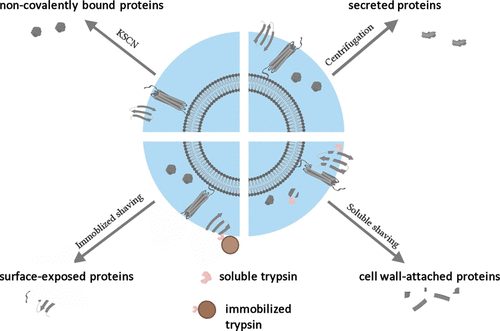当前位置:
X-MOL 学术
›
J. Proteome Res.
›
论文详情
Our official English website, www.x-mol.net, welcomes your
feedback! (Note: you will need to create a separate account there.)
Tryptic Shaving of Staphylococcus aureus Unveils Immunodominant Epitopes on the Bacterial Cell Surface.
Journal of Proteome Research ( IF 3.8 ) Pub Date : 2020-06-12 , DOI: 10.1021/acs.jproteome.0c00043 Annette Dreisbach 1 , Min Wang 1 , Magdalena M van der Kooi-Pol 1 , Ewoud Reilman 1 , Dennis G A M Koedijk 1 , Ruben A T Mars 1 , José Duipmans 2 , Marcel Jonkman 2 , Joris J Benschop 3 , Hendrik P J Bonarius 4 , Herman Groen 4 , Michael Hecker 5 , Andreas Otto 5 , Katrin Bäsell 5 , Jörg Bernhardt 5 , Jaap Willem Back 3 , Dörte Becher 5 , Girbe Buist 1 , Jan Maarten van Dijl 1
Journal of Proteome Research ( IF 3.8 ) Pub Date : 2020-06-12 , DOI: 10.1021/acs.jproteome.0c00043 Annette Dreisbach 1 , Min Wang 1 , Magdalena M van der Kooi-Pol 1 , Ewoud Reilman 1 , Dennis G A M Koedijk 1 , Ruben A T Mars 1 , José Duipmans 2 , Marcel Jonkman 2 , Joris J Benschop 3 , Hendrik P J Bonarius 4 , Herman Groen 4 , Michael Hecker 5 , Andreas Otto 5 , Katrin Bäsell 5 , Jörg Bernhardt 5 , Jaap Willem Back 3 , Dörte Becher 5 , Girbe Buist 1 , Jan Maarten van Dijl 1
Affiliation

|
The opportunistic pathogen Staphylococcus aureus has become a major threat for human health and well-being by developing resistance to antibiotics and by fast evolution into new lineages that rapidly spread within the healthy human population. This calls for development of active or passive immunization strategies to prevent or treat acute phase infections. Since no such anti-staphylococcal immunization approaches are available for clinical implementation, the present studies were aimed at identifying new leads for their development. For this purpose, we profiled the cell-surface-exposed staphylococcal proteome under infection-mimicking conditions by combining two approaches for “bacterial shaving” with immobilized or soluble trypsin and subsequent mass spectrometry analysis of liberated peptides. In parallel, non-covalently cell-wall-bound proteins extracted with potassium thiocyanate and the exoproteome fraction were analyzed by gel-free proteomics. All data are available through ProteomeXchange accession PXD000156. To pinpoint immunodominant bacterial-surface-exposed epitopes, we screened selected cell-wall-attached proteins of S. aureus for binding of immunoglobulin G from patients who have been challenged by different types of S. aureus due to chronic wound colonization. The combined results of these analyses highlight particular cell-surface-exposed S. aureus proteins with highly immunogenic exposed epitopes as potential targets for development of protective anti-staphylococcal immunization strategies.
中文翻译:

金黄色葡萄球菌的胰蛋白酶刮除可在细菌细胞表面上显示免疫敏化表位。
机会病原体金黄色葡萄球菌通过发展对抗生素的抗药性以及迅速进化成新的谱系,这些新的谱系已迅速发展到健康人群中,已成为对人类健康和福祉的主要威胁。这要求开发主动或被动免疫策略以预防或治疗急性期感染。由于尚无此类抗葡萄球菌免疫方法可用于临床实施,因此本研究旨在确定其开发的新线索。为此,我们结合两种“细菌剃须”方法与固定化或可溶性胰蛋白酶结合,然后对释放肽进行质谱分析,从而在模仿感染的条件下对细胞表面暴露的葡萄球菌蛋白质组进行了分析。在平行下,用无凝胶蛋白质组学分析了用硫氰酸钾提取的非共价细胞壁结合蛋白和外蛋白组。所有数据均可通过ProteomeXchange部件号PXD000156获得。为了查明免疫显性细菌表面暴露的表位,我们筛选了细胞壁附着蛋白金黄色葡萄球菌与来自慢性伤口定植的不同类型金黄色葡萄球菌挑战的患者的免疫球蛋白G结合。这些分析的综合结果突出了具有高度免疫原性暴露表位的特定细胞表面暴露金黄色葡萄球菌蛋白,作为开发保护性抗葡萄球菌免疫策略的潜在目标。
更新日期:2020-08-08
中文翻译:

金黄色葡萄球菌的胰蛋白酶刮除可在细菌细胞表面上显示免疫敏化表位。
机会病原体金黄色葡萄球菌通过发展对抗生素的抗药性以及迅速进化成新的谱系,这些新的谱系已迅速发展到健康人群中,已成为对人类健康和福祉的主要威胁。这要求开发主动或被动免疫策略以预防或治疗急性期感染。由于尚无此类抗葡萄球菌免疫方法可用于临床实施,因此本研究旨在确定其开发的新线索。为此,我们结合两种“细菌剃须”方法与固定化或可溶性胰蛋白酶结合,然后对释放肽进行质谱分析,从而在模仿感染的条件下对细胞表面暴露的葡萄球菌蛋白质组进行了分析。在平行下,用无凝胶蛋白质组学分析了用硫氰酸钾提取的非共价细胞壁结合蛋白和外蛋白组。所有数据均可通过ProteomeXchange部件号PXD000156获得。为了查明免疫显性细菌表面暴露的表位,我们筛选了细胞壁附着蛋白金黄色葡萄球菌与来自慢性伤口定植的不同类型金黄色葡萄球菌挑战的患者的免疫球蛋白G结合。这些分析的综合结果突出了具有高度免疫原性暴露表位的特定细胞表面暴露金黄色葡萄球菌蛋白,作为开发保护性抗葡萄球菌免疫策略的潜在目标。









































 京公网安备 11010802027423号
京公网安备 11010802027423号